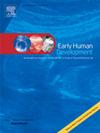出生大小与青春期和成年期BMI轨迹和波动的关系:对两个芬兰双胞胎队列的纵向研究
IF 2
3区 医学
Q2 OBSTETRICS & GYNECOLOGY
引用次数: 0
摘要
宫内条件对日后体重增加的影响尚不清楚。我们使用双胞胎设计研究了出生尺寸特征(体重、身长和体重指数(PI))与青春期和成年期体重指数(BMI)轨迹和波动的关系,这为遗传和环境因素的作用提供了见解。数据和方法来自两个芬兰双胞胎队列的数据,包括9850个双胞胎个体(48%为男性)。在出生时以及青春期和成年期的不同年龄(FinnTwin12为11.5-37岁;FinnTwin16为16-34岁)测量体重和身高。BMI在青春期和成年期不同阶段的轨迹被计算为BMI的差异除以两次测量之间的时间间隔。BMI波动被评估为每个阶段BMI轨迹的方差。使用线性回归模型来检验出生尺寸特征与青春期和成年期BMI轨迹和波动的关系。评估基线BMI和出生特征之间的相互作用。进行配对内分析,以评估在控制遗传效应的情况下,确定的关联是否持续存在。结果青少年早期bmi轨迹与出生PI呈正相关,与出生体重和出生身高呈负相关。青春期中期的BMI轨迹与出生长度呈正相关,与出生体重负相关。在青春期后期,PI与BMI轨迹呈负相关。此外,成年期BMI波动与出生体重和身高呈负相关。在解释青春期和成年期不同阶段的BMI轨迹和波动时,没有发现出生尺寸特征和基线BMI之间有显著的相互作用。在确定的关联中,没有一个在配对内分析中保持显著性。结论出生尺寸对BMI的发展有长期影响。然而,这些关联可能不是由于宫内环境,而是可能表明共同遗传因素的作用。本文章由计算机程序翻译,如有差异,请以英文原文为准。
Associations of birth size with BMI trajectories and fluctuation across adolescence and adulthood: A longitudinal study of two Finnish twin cohorts
Introduction
The influence of intrauterine conditions on later weight gain remains unclear. We examined the associations of birth size characteristics (weight, length, and ponderal index (PI)) with body mass index (BMI) trajectories and fluctuation in adolescence and adulthood using a twin design, which provides insights into the role of genetic and environmental factors.
Data and methods
Data from two Finnish twin cohorts including 9850 twin individuals (48 % males) were used. Weight and length or height were measured at birth and at different ages during adolescence and adulthood (11.5–37 years in FinnTwin12; 16–34 years in FinnTwin16). BMI trajectories across different stages of adolescence and adulthood were calculated as the difference in BMI divided by the time elapsed between measurements. BMI fluctuation was assessed as the variance of BMI trajectories at each stage. Linear regression models were used to examine the associations of birth size characteristics with BMI trajectories and fluctuation in adolescence and adulthood. Interactions between baseline BMI and birth characteristics were assessed. Within-pair analysis was performed to assess whether the identified associations persist while controlling for genetic effects.
Results
BMI trajectories during early adolescence were positively associated with birth PI and negatively with birth weight and length. BMI trajectories during middle adolescence were positively associated with birth length and negatively with birth weight. PI showed a negative association with BMI trajectories in late adolescence. Moreover, BMI fluctuation in adulthood was negatively associated with birth weight and length. No significant interactions were found between birth size characteristics and baseline BMI in explaining BMI trajectories and fluctuation at different stages of adolescence and adulthood. Among the identified associations, none remained significant in within-pair analysis.
Conclusion
Our findings suggest that birth size has a long-term influence on BMI development. However, these associations may not be due to the intrauterine environment but may rather indicate the role of shared genetic factors.
求助全文
通过发布文献求助,成功后即可免费获取论文全文。
去求助
来源期刊

Early human development
医学-妇产科学
CiteScore
4.40
自引率
4.00%
发文量
100
审稿时长
46 days
期刊介绍:
Established as an authoritative, highly cited voice on early human development, Early Human Development provides a unique opportunity for researchers and clinicians to bridge the communication gap between disciplines. Creating a forum for the productive exchange of ideas concerning early human growth and development, the journal publishes original research and clinical papers with particular emphasis on the continuum between fetal life and the perinatal period; aspects of postnatal growth influenced by early events; and the safeguarding of the quality of human survival.
The first comprehensive and interdisciplinary journal in this area of growing importance, Early Human Development offers pertinent contributions to the following subject areas:
Fetology; perinatology; pediatrics; growth and development; obstetrics; reproduction and fertility; epidemiology; behavioural sciences; nutrition and metabolism; teratology; neurology; brain biology; developmental psychology and screening.
 求助内容:
求助内容: 应助结果提醒方式:
应助结果提醒方式:


